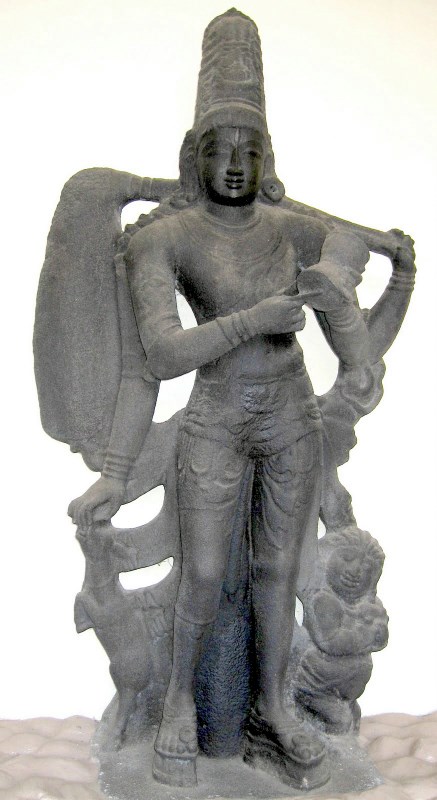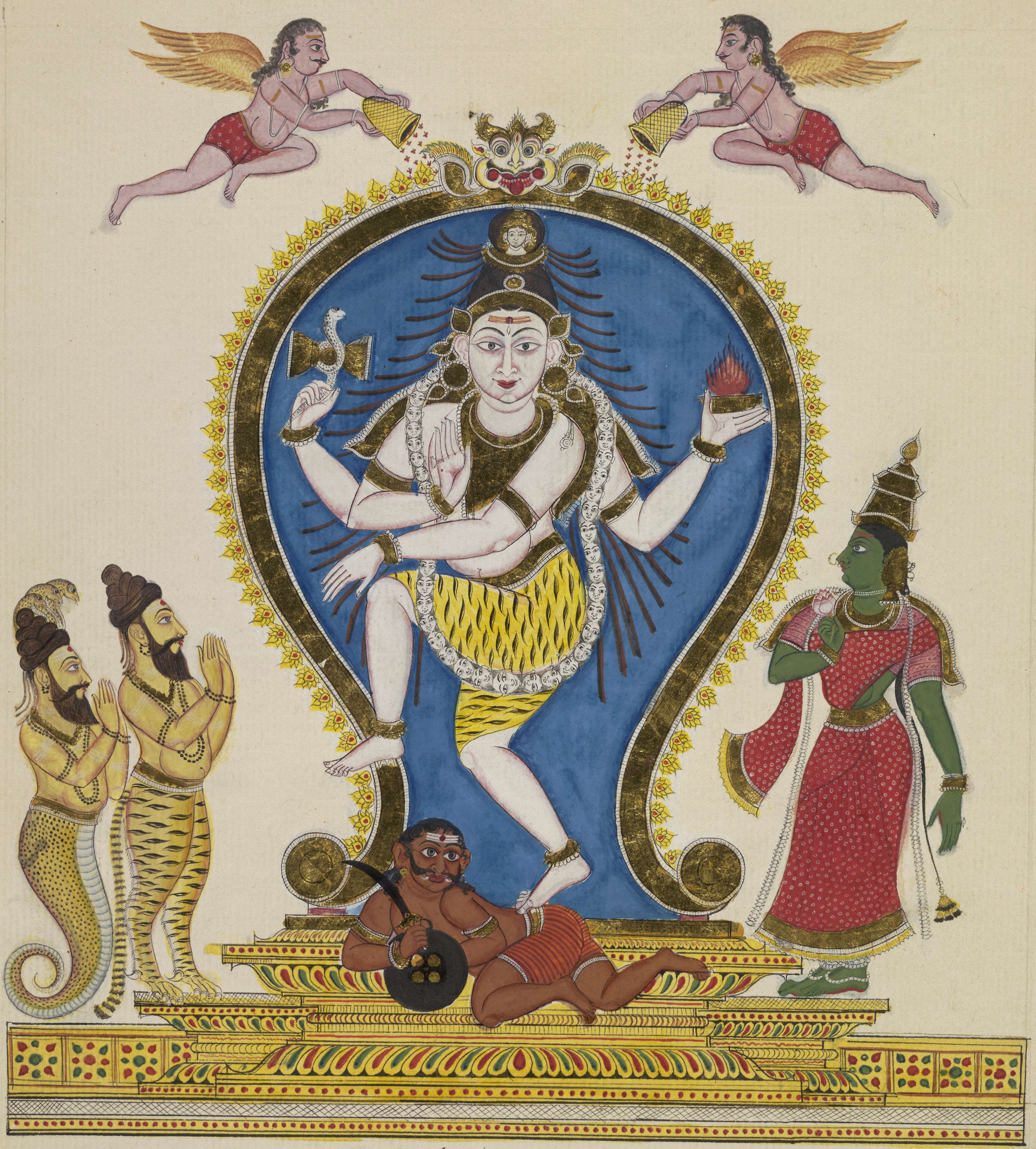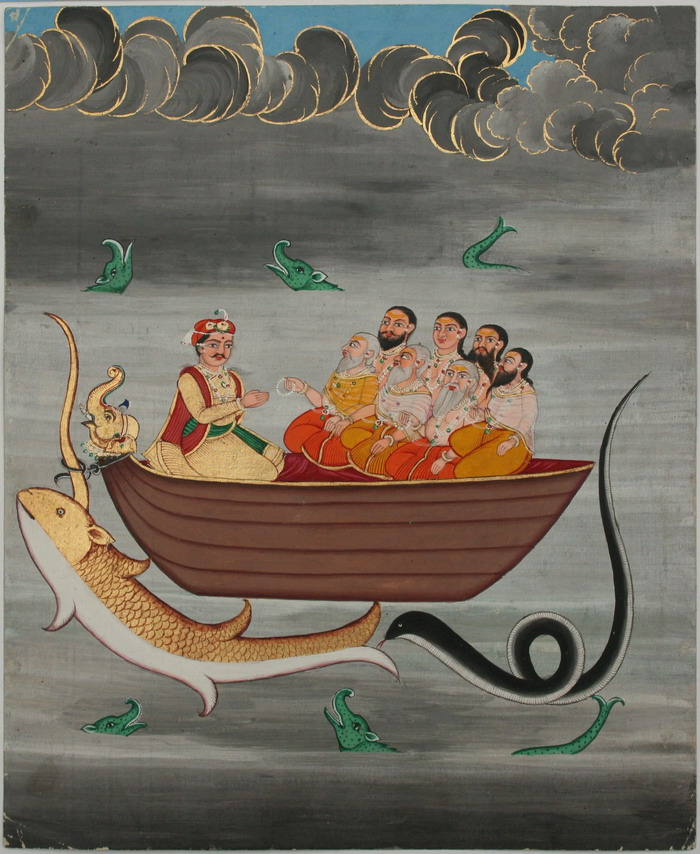|
Bhikshatana
Bhikshatana (; ; literally, "wandering about for alms, mendicancy") or Bhikshatana-murti () is an aspect of the Hinduism, Hindu god Shiva as the "Supreme mendicant" or the "Supreme Beggar". Bhikshtana is depicted as a nude four-armed man adorned with ornaments who holds a begging bowl in his hand and is followed by demonic attendants and love-sick women. Bhikshatana is considered a gentler form of Shiva's fierce aspect Bhairava and a gentle phase between Bhairava's two gruesome forms, one of which decapitates one head of the four headed god Brahma and Kankalamurti, the other of which kills the god Vishnu's gatekeeper. Bhikshatana is the form of Bhairava that Shiva assumes to atone for his sin of severing Brahma's fifth head. He wanders the universe in the form of a naked Kapalika, Kapali mendicant, begging for alms with Brahma's kapala (skullcup) as his begging bowl, until his sin is expiated upon reaching the holy city of Varanasi. Another legend describes Bhikshatana's visit ... [...More Info...] [...Related Items...] OR: [Wikipedia] [Google] [Baidu] |
Kankalamurti
Kankalamurti (Sanskrit: कङ्कालमूर्ति, romanized: ''Kaṅkālamūrti,'' lit''."''skeleton form''"''), also known as Kankala ("skeleton") or Kankala-Bhairava, is an iconographical form of the Hindu god Shiva. He is often associated with a fearsome aspect of Shiva, Bhairava, and also considered to be the latter's aspect. Kankalamurti is popular in South Indian temples of Shiva, but almost unknown in North India. He is described in legends to have been defeated and slain by Vishnu's army-chief and gate-keeper Vishvaksena or Vishnu's avatar Vamana. He is depicted as a four-armed man with a ''kankala-danda'' (skeleton-staff) in his hand and followed by ''bhuta gana''s (ghostly attendants) and love-sick women. Legend Kankalamurti is one of the three most popular aspects of Bhairava; the others being Brahmashiraschedaka-murti and Bhikshatana-murti. Shiva – as the terrifying Bhairava – cuts the fifth head of the creator-god Brahma (an act iconographically depi ... [...More Info...] [...Related Items...] OR: [Wikipedia] [Google] [Baidu] |
Shiva
Shiva (; , ), also known as Mahadeva (; , , Help:IPA/Sanskrit, [mɐɦaːd̪eːʋɐh]) and Hara, is one of the Hindu deities, principal deities of Hinduism. He is the God in Hinduism, Supreme Being in Shaivism, one of the major traditions within Hinduism. Shiva is known as ''The Destroyer'' within the Trimurti, the Hinduism, Hindu trinity which also includes Brahma and Vishnu. In the Shaivite tradition, Shiva is the Supreme Lord who creates, protects and transforms the universe. In the goddess-oriented Shaktism, Shakta tradition, the Supreme Goddess (Devi) is regarded as the energy and creative power (Shakti) and the equal complementary partner of Shiva. Shiva is one of the five equivalent deities in Panchayatana puja of the Smarta Tradition, Smarta tradition of Hinduism. Shiva has many aspects, benevolent as well as fearsome. In benevolent aspects, he is depicted as an Omniscience, omniscient yogi who lives an Asceticism#Hinduism, ascetic life on Kailasa as well as a house ... [...More Info...] [...Related Items...] OR: [Wikipedia] [Google] [Baidu] |
Annamalaiyar Temple
The Annamalaiyar Temple or Arunachalesvara Temple or Tiruvannamalai Temple is a Hindu temple dedicated to the god Shiva and goddess Parvati. It is located at the base of Annamalai hill in the town of Tiruvannamalai in Tamil Nadu, India. It is significant to the Hindu sect of Shaivism as one of the temples associated with the five elements, the '' Pancha Bhuta Sthalas'', and specifically the element of fire, or Agni. Siva is worshiped as Annamalaiyar or Arunachalesvara, and is represented by the ''lingam'', with his idol being referred to as ''Agni lingam''. Parvati is worshipped as Unnamalai or Apitakuchambal, and is represented by the yoni, with her idol being referred to as ''Agni yoni''. The two presiding deities were revered in the 7th century CE Tamil Saiva canonical work, the ''Tevaram'', written by Tamil saint poets known as the Nayanars and classified as '' Paadal Petra Sthalam''. The 9th century CE Shaiva saint poet Manikkavacakar composed the '' Tiruvempavai'' here. ... [...More Info...] [...Related Items...] OR: [Wikipedia] [Google] [Baidu] |
Nataraja
Nataraja (/ n̪əʈəɾɑd͡ʒᵊ/ ,, ; , ''Naṭarājar'' Telugu: నటరాజు,''Naṭarāju''), also known as Adalvallan (), is a depiction of Shiva, one of the main deities in Hinduism, as the divine cosmic dancer. His dance is called the tandava.''Encyclopædia Britannica'' (2015) The pose and artwork are described in many Hindu texts such as the ''Tevaram'' and '' Thiruvasagam'' in Tamil and the ''Amshumadagama'' and ''Uttarakamika agama'' in Sanskrit and the Grantha texts. The dance ''murti'' is featured in all major Hindu temples of Shaivism, and is a well-known sculptural symbol in India and popularly used as a symbol of Indian culture, as one of the finest illustrations of Hindu art. This form is also referred to as Kuththan (), Sabesan (), and Ambalavanan () in various Tamil texts. The sculpture is symbolic of Shiva as the lord of dance and dramatic arts, with its style and proportions made according to Hindu texts on arts. Tamil devotional texts such as ... [...More Info...] [...Related Items...] OR: [Wikipedia] [Google] [Baidu] |
Vamana Purana
The ''Vamana Purana'' (, IAST: ), is an ancient Sanskrit text that is at least 1,000 years old and is one of the eighteen major Puranas of Hinduism. The text is named after one of the incarnations of Vishnu and probably was a Vaishnava text in its origin. However, the modern surviving manuscripts of ''Vamana Purana'' are more strongly centered on Shiva, while containing chapters that revere Vishnu and other Hindu gods and goddesses. It is considered a Shaiva text. Further, the text hardly has the character of a Purana, and is predominantly a collection of ''Mahatmyas'' (travel guides) to many Shiva-related places in India with legends and mythology woven in. The extant manuscripts of ''Vamana Purana'' exist in various versions, likely very different from the original, and show signs of revision over time and regions. It has been published by All India Kashiraj Trust in two rounds. The first round had 95 chapters, while the critical edition (edited by Anand Swarup Gupta, and ... [...More Info...] [...Related Items...] OR: [Wikipedia] [Google] [Baidu] |
Varaha Purana
The ''Varaha Purana'' (, ) is a Sanskrit text from the Puranas genre of literature in Hinduism. It belongs to the Vaishnavism literature corpus praising Narayana (Vishnu), but includes chapters dedicated to praising and centered on Shiva and Shakti. The text exists in many versions, with major sections lost to history. The text has been estimated to have been first completed between the 10th and 12th centuries, and continuously revised thereafter. The surviving manuscripts of this text are notable, like ''Linga Purana'', because they do not cover the required ''Panchalakshana'' (five characteristics) expected in a Purana. Scholars have questioned whether it really qualifies as a Purana, and whether the extant manuscripts are merely a religious manual largely focussed on Vaishnava practices, with sections that also praise Shiva, Shakti and other gods in a secular way. The ''Varaha Purana'' includes mythology, particularly of the Varaha incarnation (avatar) of Vishnu rescuing the ... [...More Info...] [...Related Items...] OR: [Wikipedia] [Google] [Baidu] |
Skanda Purana
The ''Skanda Purana'' ( IAST: Skanda Purāṇa) is the largest '' Mukhyapurāṇa'', a genre of eighteen Hindu religious texts. The text contains over 81,000 verses, and is of Shaivite literature, titled after Skanda, a son of Shiva and Parvati (who is also known as Murugan in Tamil literature). While the text is named after Skanda, he does not feature either more or less prominently in this text than in other Shiva-related Puranas. The text has been an important historical record and influence on the Hindu traditions and rituals related to the war-god Skanda. The earliest text titled ''Skanda Purana'' likely existed by the 8th century CE, but the ''Skanda Purana'' that has survived into the modern era exists in many versions. It is considered as a living text, which has been widely edited, over many centuries, creating numerous variants. The common elements in the variant editions encyclopedically cover cosmogony, mythology, genealogy, dharma, festivals, gemology, temples ... [...More Info...] [...Related Items...] OR: [Wikipedia] [Google] [Baidu] |
Matsya Purana
The ''Matsya Purana'' (IAST: Matsya Purāṇa) is one of the eighteen major Puranas (Mahapurana), and among the oldest and better preserved in the Puranic genre of Sanskrit literature in Hinduism. The text is a Vaishnavism text named after the half-human and half-fish avatar of Vishnu. However, the text has been called by the 19th-century Sanskrit scholar Horace Hayman Wilson, "although a Shaivism (Shiva-related) work, it is not exclusively so"; the text has also been referred to one that simultaneously praises various Hindu gods and goddesses. The ''Matsya Purana'' has survived into the modern era in many versions, varying in the details but almost all of the published versions have 291 chapters, except the Tamil language version, written in Grantha script, which has 172 chapters. The text is notable for providing one of earliest known definition of a Purana genre of literature. A history written with five characteristics is called a Purana, states ''Matsya Purana'', otherwise ... [...More Info...] [...Related Items...] OR: [Wikipedia] [Google] [Baidu] |
Shiva Purana
The ''Shiva Purana'' (original Sanskrit title: Śivapurāṇa (शिवपुराण) and Śivamahāpurāṇa (शिवमहापुराण) is one of eighteen major texts of the '' Purana'' genre of Sanskrit texts in Hinduism, and part of the Shaivism literature corpus. It primarily revolves around the Hindu god Shiva and goddess Parvati, but references and reveres all gods. The ''Shiva Purana'' asserts that it once consisted of 100,000 verses set out in twelve Samhitas (Books); however, the Purana adds that it was abridged by Sage Vyasa before being taught to Romaharshana. The surviving manuscripts exist in many different versions and content, with one major version with seven books (traced to South India), another with six books, while the third version traced to the medieval Bengal region of the Indian subcontinent with no books but two large sections called ''Purva-Khanda'' (Previous Section) and ''Uttara-Khanda'' (Later Section). The two versions that include books, ... [...More Info...] [...Related Items...] OR: [Wikipedia] [Google] [Baidu] |
Rishi
In Indian religions, a ''rishi'' ( ) is an accomplished and enlightened person. They find mention in various Vedic texts. Rishis are believed to have composed hymns of the Vedas. The Post-Vedic tradition of Hinduism regards the rishis as "great yogis" or "sages" who after intense meditation (Tapas (Sanskrit), tapas) realized the supreme truth and eternal knowledge, which they composed into hymns.Hartmut Scharfe (2002), Handbook of Oriental Studies, BRILL Academic, , pp. 13–15. The term appears in Pali literature as Ishi; in Buddhism they can be either Buddhas, Pratyekabuddha, Paccekabuddhas, Arhat, Arahats or a Buddhist monasticism, monk of high rank. Etymology According to Indian tradition, the word may be derived from two different meanings of the root 'rsh' (). Sanskrit grammarians derive this word from the second meaning: "to go, to move". V. S. Apte gives this particular meaning and derivation, and Monier-Williams also gives the same, with some qualification. Another ... [...More Info...] [...Related Items...] OR: [Wikipedia] [Google] [Baidu] |
Kurma Purana
The ''Kurma Purana'' (IAST: Kūrma Purāṇa) is one of the eighteen Mahapuranas, and a medieval era Vaishnavism text of Hinduism. The text is named after the tortoise avatar of Vishnu. The manuscripts of ''Kurma Purana'' have survived into the modern era in many versions. The number of chapters vary with regional manuscripts, and the critical edition (edited by Anand Swarup Gupta, and published by the All-India Kashiraj Trust, Varanasi) of the ''Kurma Purana'' has 95 chapters. Tradition believes that the ''Kurma Purana'' text had 17,000 verses, the extant manuscripts have about 6,000 verses. The text, states Ludo Rocher, is the most interesting of all the Puranas in its discussion of religious ideas, because while it is a Vaishnavism text, Vishnu does not dominate the text. Instead, the text covers and expresses reverence for Vishnu, Shiva and Shakti with equal enthusiasm. The ''Kurma Purana'', like other Puranas, includes legends, mythology, geography, ''Tirtha'' (pilgrimage ... [...More Info...] [...Related Items...] OR: [Wikipedia] [Google] [Baidu] |






